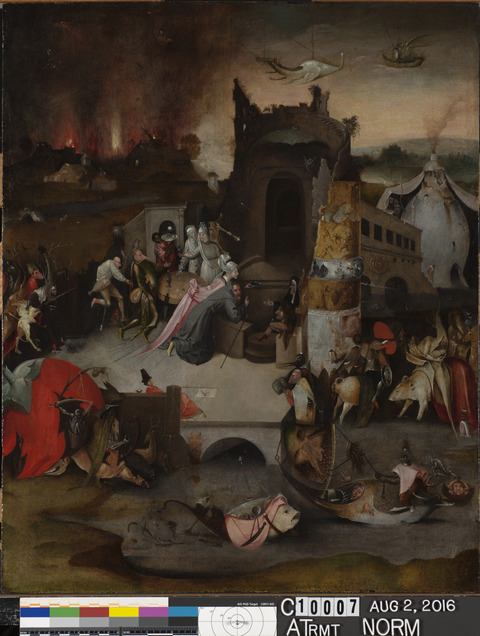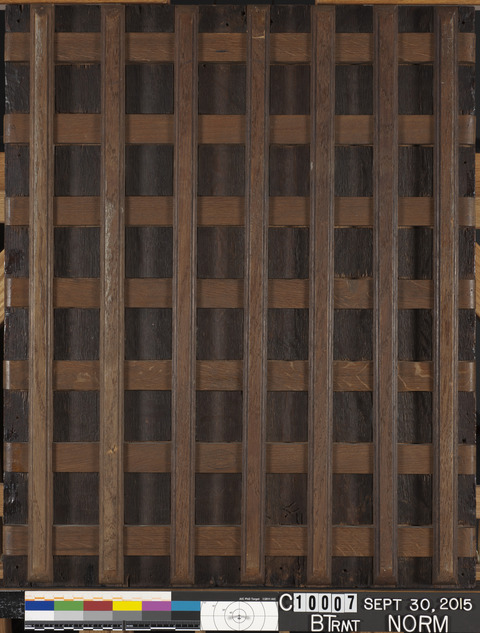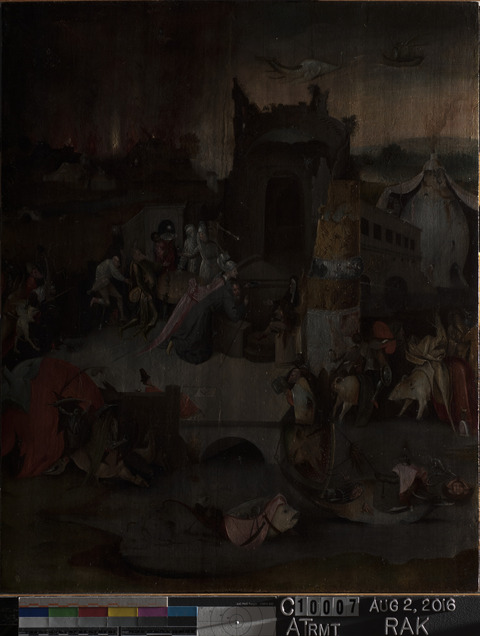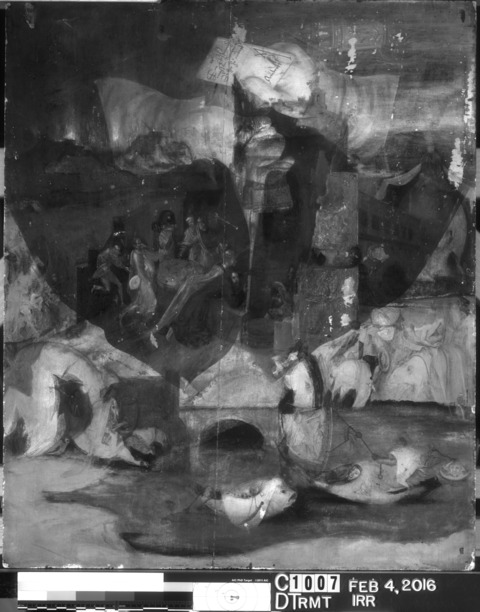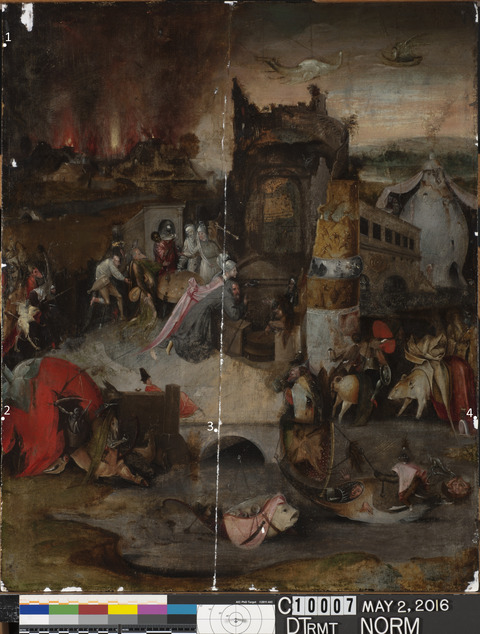Overview:
Accession number: 2020.1
Artist: Follower of Hieronymus Bosch
Title: Temptation of St. Anthony
Materials: Oil (untested) on oak panel
Date of creation: After 1531
Previous number/accession number: C10007
Dimensions: 60.5 × 49 cm
Conservator/examiner: Erica Schuler with contributions from Roxane Sperber
Examination completed: 2015, revised 2020
Distinguishing Marks
Front:
None
Back:
None
Other:
Item 1. Underlying portrait of a male sitter made visible through infrared reflectography. A legible inscription written on a card held by the sitter reads, “Dem Erssamen und/ weijssenn Heronymus/ Sulzer zu anntorff/ Antorff,” which translates as “To the honorable and wise Heronymus Sulzer at Antwerp.”
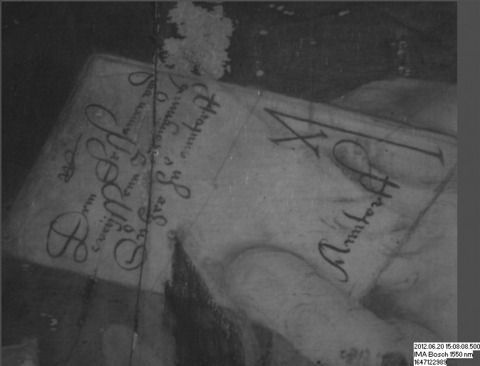
Item 2. A figural motif with script, likely “MORS OMNIA V[ICIT],” visible on what appears to be a book spine.
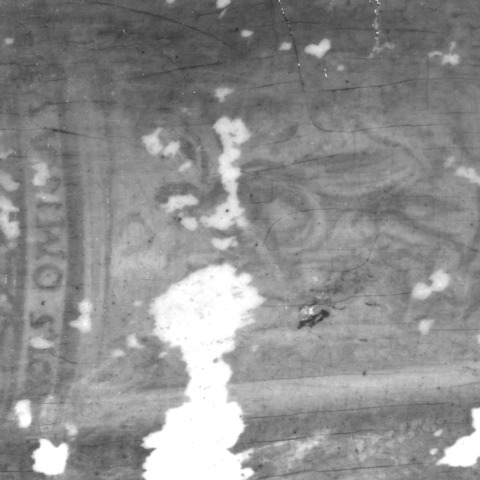
Item 3. Stamp.
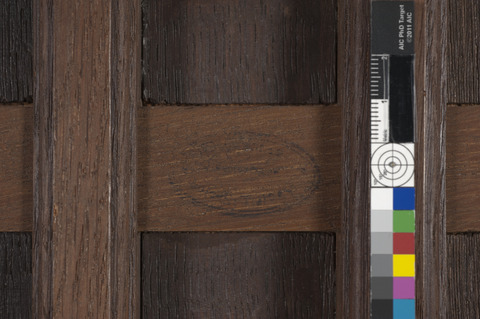
Summary of Treatment History
The painting has undergone extensive examination, documentation, and analysis since 1971 when the work was brought to the Indianapolis Museum of Art on permanent loan. A series of condition assessments and treatments were carried out on the collection around the time the works were moved from the Clowes' residence to the IMA in 1971. A condition report by Paul Spheeris in October of that year, likely carried out before the paintings were relocated, described the painting as “O.K.” He recommended cleaning for the sake of appearance but not for the safety of the painting.1
A second condition assessment was carried out upon arrival of the painting at the IMA. This assessment describes the work as in stable condition, and no work was deemed necessary.2 In 1974, condition assessment, treatment, and investigation of the collection was carried out by the Intermuseum Conservation Association at Oberlin College. This document describes this painting as having a “natural resin varnish which has yellowed and darked with a crackle pattern in the varnish coating.” Further examination was recommended.3 Microscopy was also performed by the Intermuseum Conservation Association Laboratory in Oberlin, Ohio.
In 1996, a memorandum summarizing treatment and examination of the Clowes Collection from the time it entered the Museum suggests that no treatment was carried out on the painting up until that point.4 However, a full investigation was carried out on the painting. X-radiography and infrared reflectography revealed an inverted half-length portrait beneath the visible composition, a copy of the central panel in Hieronymus Bosch’s triptych Temptations of St. Anthony of about 1500 (Lisbon, Portugal) (tech. fig. 4). Dendrochronology to date the wood panel was carried out by Peter Klein in 1994.5
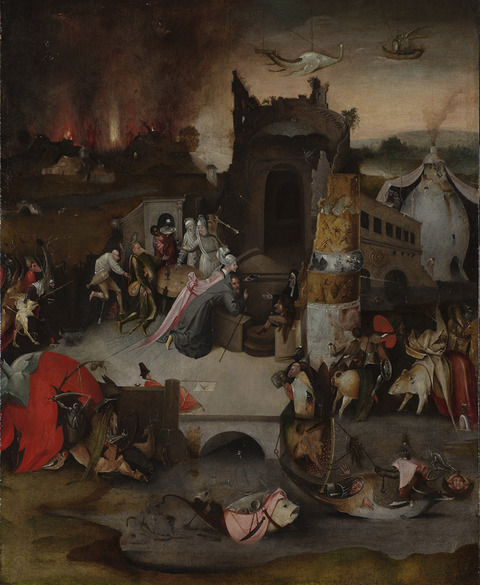
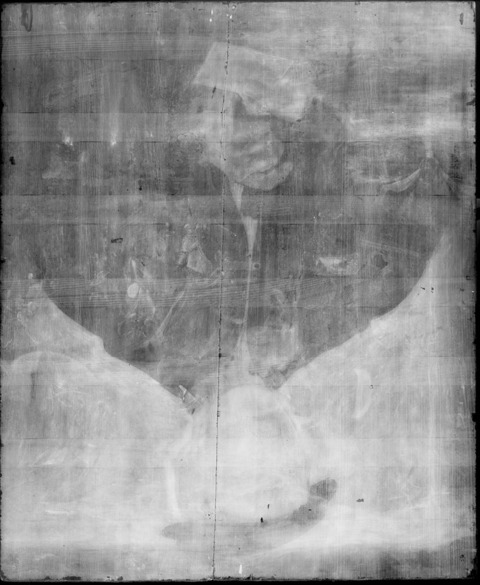
The Clowes Temptation has undergone multiple treatment campaigns since its creation to address structural as well as aesthetic concerns; however, only two records referencing aesthetic-focused treatments have been preserved and are retained within the historical files at the Indianapolis Museum of Art. A 1945 letter addressed to William Valentiner of the Detroit Institute of Arts briefly mentions that the painting was cleaned but offers no further details concerning condition, documentation, or the extent of treatment.6 In 2016, the painting underwent treatment to visually correct the picture’s darkened and extremely disfigured aesthetics and involved the removal of dirt, grime, and varnish; the reduction of old restoration paint; compensation for loss; extensive inpainting to visually reintegrate loss and abrasion with original paint; and varnish application. Technical figure 5 shows the painting as it appeared prior to the 2016 treatment campaign.
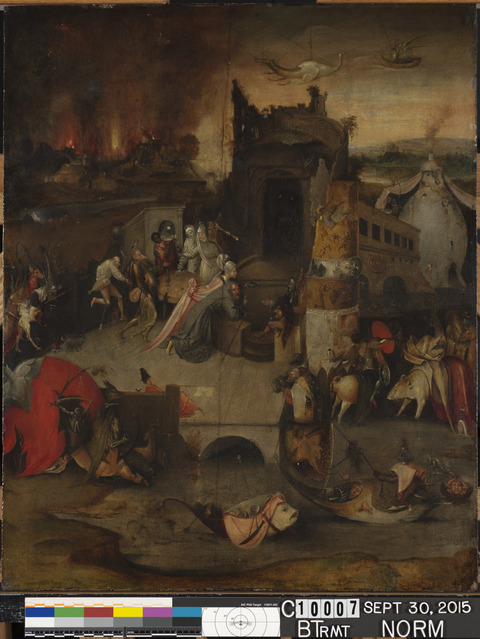
Current Condition Summary
At present the painting’s overall structure and appearance are in good condition. Through a series of past and recent treatment campaigns, both structural and aesthetic condition concerns were addressed. During a past treatment, a 14-member movable cradle was attached to the back of the vertically grained oak panel. Shallow channels were cut directly into the panel’s back to accommodate the fixed (vertical) and mobile (horizontal) cradle members. Although it is probable that the overall thickness of the support was reduced slightly during this process, the panel does not appear to have been extensively thinned. The current dimensions (height, width, and depth) appear to relate closely to those of the panel’s original construction, including a slight variation in depth across the width of the support (1.2 cm at the proper-left edge to 0.8 cm at the proper-right edge). The support remains secure, and in addition, the cradle secures a split that developed at the join between the two planks. The horizontal members remain mobile and continue to accommodate slight movement of the support as the wood responds to minor fluctuations in temperature and relative humidity within its environment. The overall rigidity induced by the cradle does not appear to compromise the painting’s structural stability at this time, and it is expected that the painting will remain secure provided storage and exhibition environments are appropriately maintained.
The paint layer exhibits very good adhesion to the support and cohesion throughout the strata, but inherent aging of original materials combined with chemically and mechanically induced damage have contributed to a condition that is confusing without visible compensation (inpainting and varnish). There are numerous small losses around the periphery and along the central join and associated crack. A minor network of age and drying cracks are present overall. Solvent and mechanical abrasion of the paint surface is evident upon close examination; yet, the 2016 treatment campaign proved successful in restoring color saturation, visual integration of loss, legibility, and surface finish.
Methods of Examination, Imaging, and Analysis
| Examination/Imaging | Analysis (no sample required) | Analysis (sample required) |
|---|---|---|
| Unaided eye | Dendrochronology | Microchemical analysis |
| Optical microscopy | Wood identification | Fiber ID |
| Incident light | Microchemical analysis | Cross-section sampling |
| Raking light | Thread count analysis | Dispersed pigment sample |
| Reflected/specular light | X-ray fluorescence spectroscopy (XRF) | Fourier-transform infrared spectroscopy (FTIR) |
| Transmitted light | Macro X-ray fluorescence scanning (MA-XRF) | Raman microspectroscopy |
| Ultraviolet-induced visible fluorescence (UV) | ||
| Infrared reflectography (IRR) | Gas chromatography–mass spectrometry (GC-MS) | |
| Infrared transmittography (IRT) | Scanning electron microscope -energy dispersive X-ray spectroscopy (SEM-EDS) | |
| Infrared luminescence | Other: | |
| X-radiography |
Technical Examination
Description of Support
Analyzed Observed
Material (fabric, wood, metal, dendrochronology results, fiber ID information, etc.):
Wood identification and dendrochronological analysis, conducted by Peter Klein on 20 July 1994, determined that the support was constructed from two oak planks originating from the Baltic/Polish region. The earliest felling date was identified as 1523, with 1531 being the earliest plausible date for the painting’s creation.7
Characteristics of Construction / Fabrication (cusping, beveled edges of panels, seams, joins, battens):
The X-radiograph shows vertically oriented grain on the two quarter-sawn oak planks that constitute the panel.8 The planks are somewhat uneven in dimension, aligned at a slight oblique angle with three wooden dowels, and secured with glue (tech. fig. 6). Although visible characteristics of construction are obscured by a 14-member auxiliary cradle, evidence of tool marks (possibly saw and plane) can be detected within the interstices of the latticed members. It is entirely plausible, however, that the noted tool marks are a hallmark of a later structural treatment and are not original to its construction, as the back was likely sanded overall in preparation for the cradle attachment. Shallow channels are cut directly into the support’s back to accommodate both the fixed (vertical) and mobile (horizontal) cradle members.
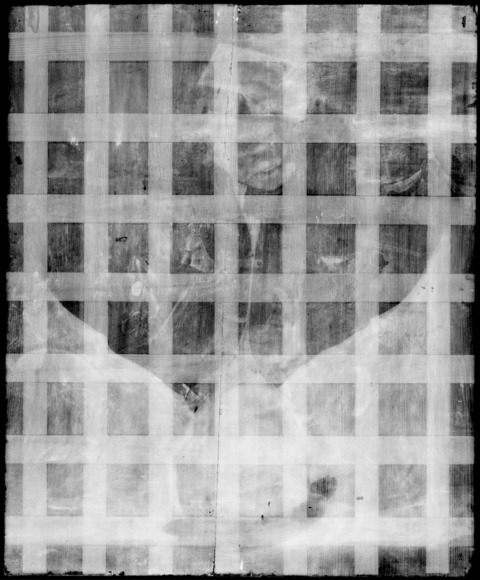
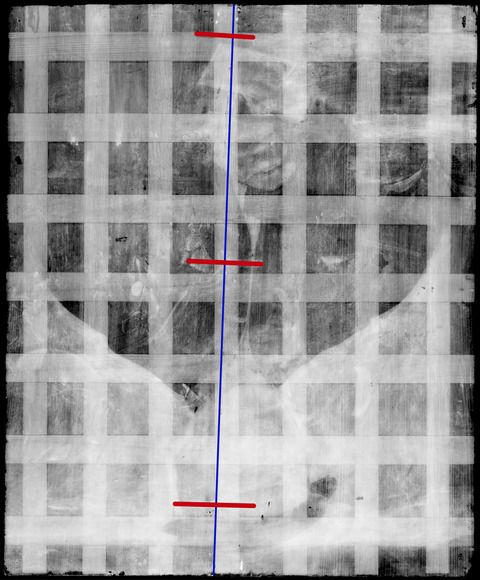
| Dimensions and Locations of Support Components | ||||
|---|---|---|---|---|
| Top (width) | Bottom (width) | Left Edge (height) | Right Edge (height) | |
| Left Plank | 23.6 cm | 21.9 cm | 60 cm | 60.5 cm |
| Right Plank | 25.4 cm | 27.1 cm | 60.7 cm | 60.5 cm |
| Top Dowel | 57.5 × 27 cm* | |||
| Central Dowel | 33 × 27 cm* | |||
| Bottom Dowel | 7.5 × 25.5 cm* | |||
Table 1: Dimensions and Locations of Support Components
*The general location is based on visual interpretation of information within the X-radiograph. Measurements are listed as H × W from the bottom-left corner and reference the approximate center of each dowel.
Thickness (for panels or boards):
The support shows a slight variation in depth across the panel’s width, measuring approximately 1.2 cm at the proper-left edge and decreasing to a depth of 0.8 cm at the proper right. The dimensions were likely altered at the time the cradle was attached to the panel’s back and the panel was sanded flat. However, evidence of extensive thinning is not apparent and the noted variation in thickness likely relates to the support’s original construction.
Shallow vertical and horizontal channels are cut into the back of the panel to accommodate each of the 14 cradle members. The depths of the individual channels vary, with the deepest part of the cut occurring at the center of the channel (approximately 0.4 cm) and tapering to less than 0.1 cm as the cut approaches the panel’s edges.
Production/Dealer’s Marks:
An illegible oval stamp is present on the sixth (from top) horizontal cradle member (tech. fig. 3).
Auxiliary Support:
Original Not original Not able to discern None
A 14-member wood cradle is attached to the panel’s back—seven vertical members, glued into a fixed position following the woodgrain, are perpendicularly crossed by seven horizontal sliding members to form a full lattice support. The vertical battens measure 60 × 2.4 × 2 cm and the horizontal battens measure 48.9 × 3 × 0.9 cm. Both vertical and horizontal members are positioned within shallow mortised channels cut parallel and transverse to the woodgrain. The depth of each channel tapers across its length with the greatest depth measured at the center of each measure (approximately 0.4 cm). An oval stamp is present on the cradle’s sixth (from top) horizontal sliding member (tech. fig. 3)—the text is illegible, and the ink is transparent to infrared irradiation.
Condition of Support
The panel shows a slight convex curve but remains generally planar, is stable, and is in good condition overall. Insecurity and damage associated with an old crack that developed at the join between the two planks that constitute the support was addressed during a past structural treatment campaign. The join is bridged by a vertical cradle member and shows no sign of recurring failure. Minor woodworm channeling is visible right of center at the bottom edge of the panel’s back (29.5 × 8.5 cm, from the bottom-left corner). Examination of the X-radiograph indicates that a few exit holes associated with the visible tunneling extend through both picture layers. Active insect infestation was not observed, and the slight damage noted appears negligible, isolated, and secured. Additionally, nails and/or screw holes from past framing and hanging hardware are visible within corners and along the edges on the back.
A 14-member, movable wood cradle is positioned within shallow channels cut directly into the support’s back; the vertical members are secured with glue. The cuts do not appear to adversely affect the stability of the support, and the sliding members remain mobile to account for slight dimensional changes of the wood. The overall rigidity induced by the cradle does not appear to adversely compromise the painting’s structural stability at this time, and it is expected that the painting will remain secure provided appropriate storage and exhibition environments are maintained.
Description of Ground
Analyzed Observed
Materials/Binding Medium:
Visual characteristics observed under magnification show that the panel was initially prepared for painting with two preparatory layers—a primary glue-based ground beneath a thin, white imprimatura. The two compositions (lower portrait painting and upper painting depicting the temptation of St. Anthony) are separated by what appears to be a thin intermediary layer of light blue oil paint (tech. fig. 6). In much of the painting this intermediary layer appears white. XRF analysis confirmed the presence of calcium in the ground layer (see table 2, sample 10). Given the panel’s attributed Northern European origin, the primary ground is most likely a chalk-based (calcium carbonate) ground bound in animal glue.
Color:
The primary glue-based ground is off-white, and the thin finishing paint layer is white in color (tech. fig. 7). Examination of exposed strata within losses around the periphery suggests that the artist of the Temptation concealed the majority of the underlying portrait with white paint (approximate bottom five-sixths of the composition—see tech. fig. 12, layer 6) then switched to light blue paint to mask the figure’s black costume in the sky (approximate top one-sixth of the composition). This is the case in a loss imaged in technical figure 7.
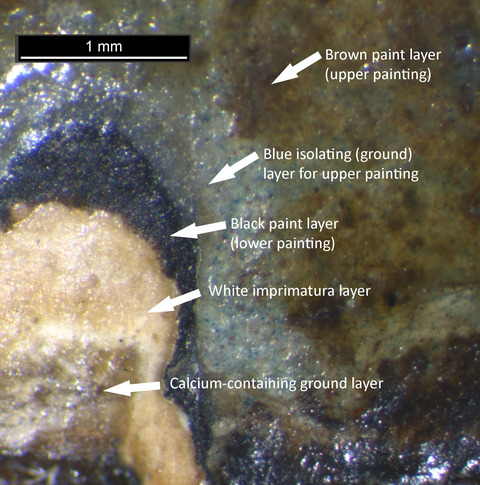
Application:
The overall uniform appearance of the picture under normal viewing conditions suggests that the primary ground was evenly applied directly to the presumably sized panel and the surface subsequently smoothed to mask surface variations and defects. Broad brushwork that does not correspond to painted contours of design in the Temptation can be observed under normal and raking illumination, which indicates that the intermediary preparatory layer was likely applied over the portrait with a coarse, flat-tipped brush.
Thickness:
The primary glue-based ground is applied comparatively thickly in relation to the thin imprimatura and intermediary layers; yet despite the combined stratigraphy of the two picture layers, the texture of the wood support remains detectable under raking illumination.
Sizing:
The painting was not analyzed to characterize or determine the presence of a size; however, the panel was likely prepared with one or more layers of animal glue prior to ground application.
Character and Appearance (Does texture of support remain detectable / prominent?):
Under normal illumination, the painting’s surface appears smooth, yet despite the complicated structure, the linear texture of the woodgrain remains markedly detectable under extreme raking light conditions.
Condition of Ground
The X-radiograph reveals that minor loss has occurred within the ground layer (see tech. fig. 4); however, such damage appears negligible and adhesion between the ground and support remains secure and in very good condition overall. With the exception of a relatively large rectangular loss measuring approximately 3 × 1.2 cm in the bottom left corner, the remaining damage noted in the X-radiograph appears to relate to minor insect infestation and mechanically induced stresses incurred through handling and display. In addition to nail holes, each corner has sustained loss measuring ≤ 1 cm from handling. Additional nail holes are present around the painting’s perimeter, as are numerous pinpoint losses and minor insect damage associated with the tunneling visible on the back (29.5 × 8.5 cm, from the bottom-left corner; see Condition of Support).
Fill and inpainting visible on the surface of the Temptation make it clear that losses in the paint layer have been filled and compensated with inpainting during past treatment campaigns. However, examination of select losses visible in the infrared reflectogram suggests that some losses were present in the paint layer of the portrait before the Temptation was painted over them. Technical figure 8 compares such an area of loss under visible light and with infrared reflectography; the visible light photomicrograph illustrates that craquelure in these areas is consistent across the area of loss onto the surrounding paint. This demonstrates that the underlying loss predated the creation of Temptation.
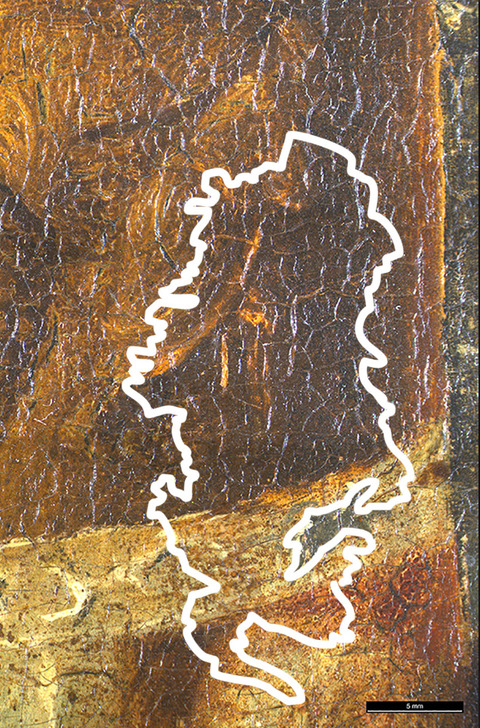
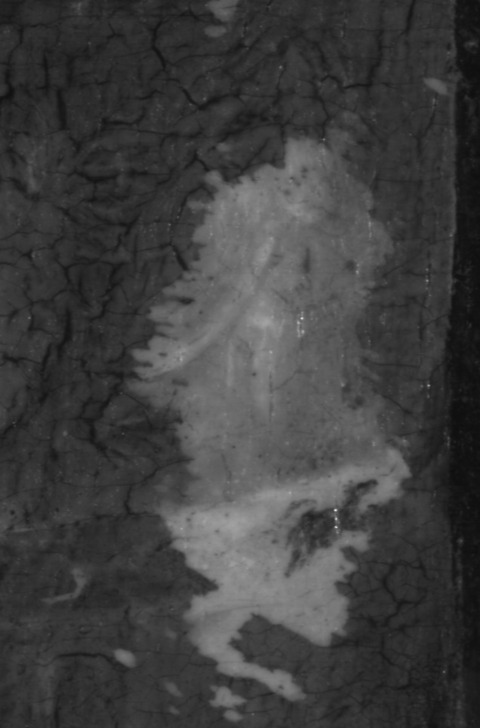
Description of Composition Planning
Methods of Analysis:
Surface observation (unaided or with magnification)
Infrared reflectography (IRR)
X-radiography9
Analysis Parameters:
| X-ray equipment | GE Inspection Technologies Type: ERESCO 200MFR 3.1, Tube S/N: MIR 201E 58-2812, EN 12543: 1.0mm, Filter: 0.8mm Be + 2mm Al, Elvacite 2045 |
|---|---|
| KV: | 25 (overall); 40 (portrait face) |
| mA: | 3 |
| Exposure time (s) | 150 (overall); 60 (portrait face) |
| Distance from X-ray tube: | 36″ |
| IRR equipment and wavelength | Opus Instruments Osiris A1 infrared camera with InGaAs array detector operating at a wavelength of 0.9–1.7µm. |
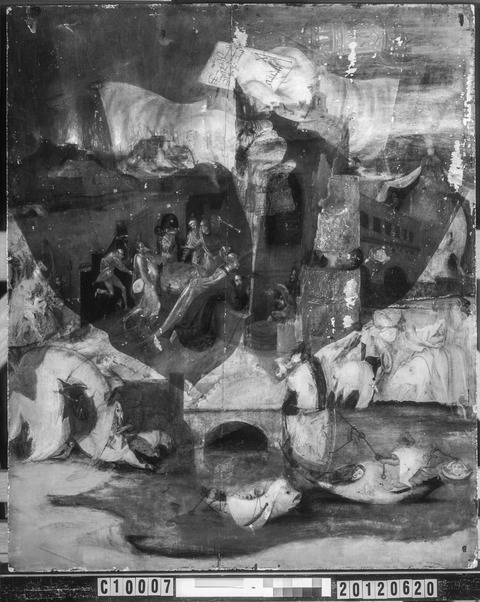
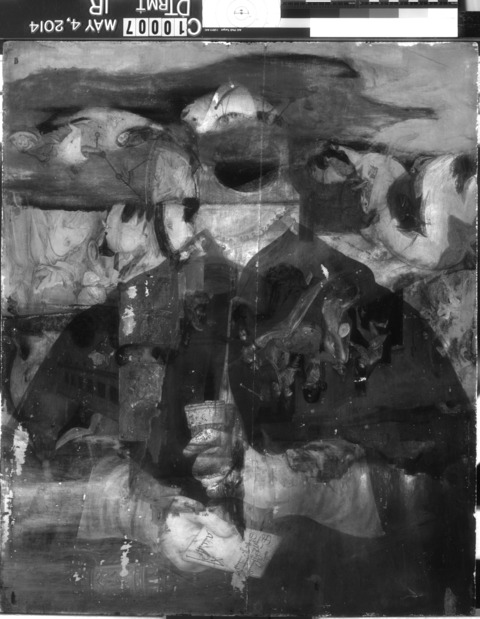
Medium/Technique:
The composition of the painting is a copy of the central panel of the triptych Temptation of St. Anthony, dating to about 1500, by the Early Netherlandish painter Hieronymus Bosch. As previously mentioned, infrared reflectography and X-radiography revealed that the Clowes Temptation is executed over a repurposed panel that originally depicted a portrait of a young man who, given the inscription on the card he holds, is presumed to be the sixteenth-century merchant Hieronymus Sulzer. The multilayered paint structure complicates the legibility of underlying strata within the infrared reflectogram and X-radiograph; however, both imaging techniques show passages of what appear to be underdrawing in the Temptation as well as the portrait (tech. figs. 9, 10). Technical figure 11 shows the strata where the underdrawing appears to be present. Sharp lines and defined contours characteristic of dry media were observed throughout; however, further analysis is necessary to interpret and characterize both the media and technique(s) employed.

Portrait: Imaging and sampling completed thus far cannot confirm the extent to which the portrait was finished prior to the panel’s reuse; however, X-radiography, infrared imaging, and cross-section analysis offer convincing evidence that portions of the composition were completed before it was concealed beneath the present composition. In addition to an observed underdrawing, a cross section removed from an area of the sitter’s face (for exact location see tech. fig. 12) shows layers of pale pink paint suggesting that, at minimum, the skin tones were blocked in with color (tech. fig. 13 layers 3, 4, 5). When enhanced, the X-radiograph of the sitter’s face shows a sharp outline around the primary contours of the face, jaw, and neck, as well as dense paint delineating the head and shoulders from the background (tech. fig. 14). A wide band of thick paint, possibly an initial outline of background paint applied with a broad brush, defines the edge of the hair, ear, and neck along the proper-left side of the sitter’s head. In addition to a detailed ruffled collar, a scalloped cloak hem, a jeweled ring, and inscriptions made visible through infrared reflectography, a marked degree of modeling with underdrawing is revealed in the sitter’s hands and sleeve (tech. fig. 10). Given the precision through which the lines of the underdrawing appear to have been executed and the absence of alterations within noted passages of compositional planning, the main contours of the portrait appear to have been preliminarily established via an indirect or direct copy method rather than a freehand approach.
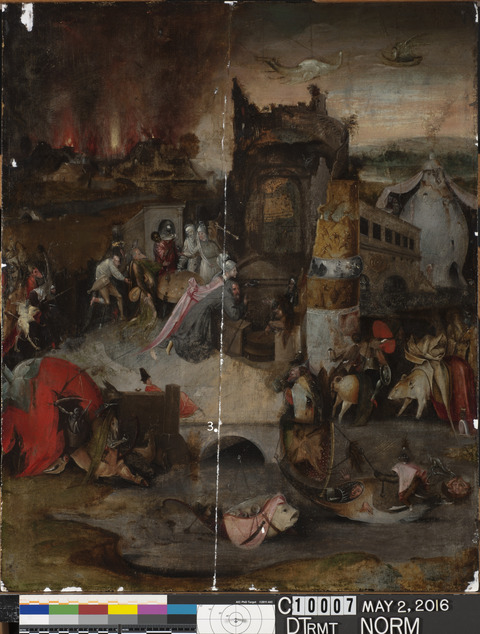
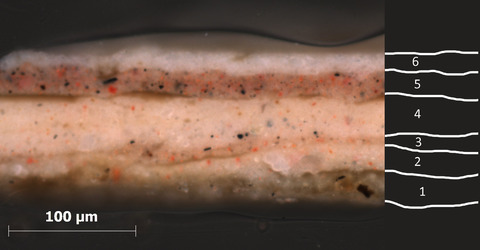
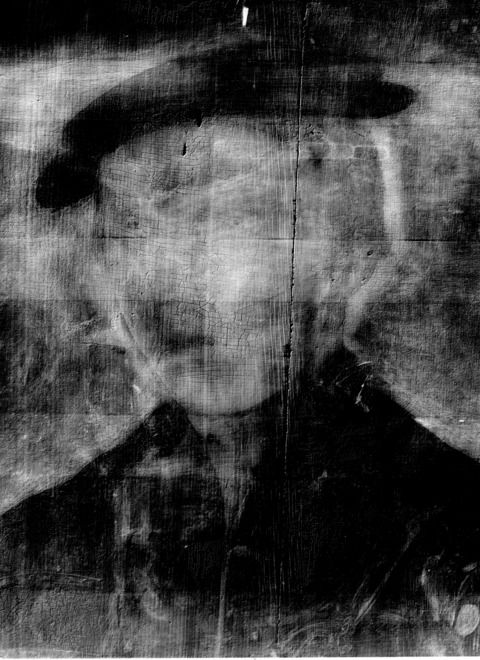
Temptation of St. Anthony: The center panel of Hieronymus Bosch’s triptych measures 131.5 × 119 cm,10 while the Clowes Temptation is executed on a comparatively narrow rectangular support, 60.5 × 49 cm. Figures and architecture within the Clowes Temptation closely imitate those of Bosch’s original composition, while forms are slightly elongated/truncated to account for the adjusted format. Where legibility of the drawing media is not obscured by the infrared-absorbent region of the underlying sitter’s black cloak, infrared reflectography shows underdrawing throughout the Temptation. Although no evidence was found that the composition was laid out in advance through the use of a specific transfer method, minor adjustments that are gestural in nature appear within passages of otherwise precisely drawn contours, indicating that the overall design was likely first copied from a template then adjusted by hand. The center-left side of technical figure 15 illustrates such a passage of underdrawing where pointed arches of the fence posts have been altered multiple times. To the immediate right, conversely, the large rat and surrounding figures show steady and sure execution. Once the drawing was complete, the artist appears to have applied bold outlines, sketching, and shading in thin dark paint to establish shadows, form, and depth.
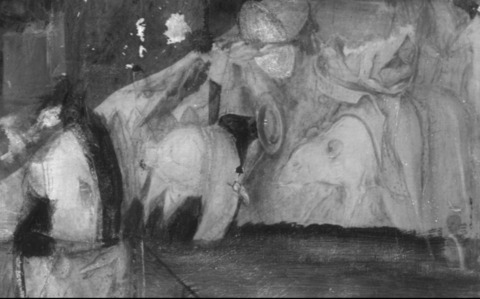
Pentimenti:
Prior to the 2016 treatment campaign, a few elements of the underlying portrait were visible through the Temptation’s picture layer, including the three gold bands and red jewel of the sitter’s ring (tech. fig. 16), creases of the shirt sleeve within the top-right corner, and the border of the sitter’s proper-left shoulder. The visibility of these elements was corrected through inpainting. At present, the sitter’s proper-left shoulder remains visible through the translucent light gray paint of the center platform, as are localized passages of the portrait’s green background within the painted bluffs of the foreground. Although past speculation has theorized that some of the visual artifacts mentioned above result from artistic intent, the 2016 examination and treatment campaign revealed a paint surface damaged by extreme chemical and mechanical abrasion and, as such, any observed pentimenti are likely a product of past human intervention and not artist technique.
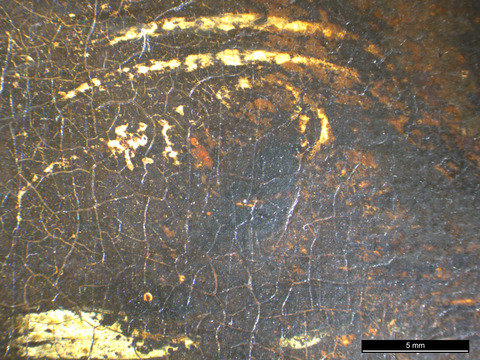
Description of Paint
Analyzed Observed
Application and Technique:
The two distinct picture layers of the portrait and the Temptation can be identified by examining the painting’s edges under magnification, while the X-radiograph and infrared reflectogram offer insight into paint application. Examination of exposed strata around the periphery suggests that the artist of the Temptation concealed the majority of the underlying portrait with white paint (approximate bottom five-sixths of the composition) but opted for translucent light blue paint to mask the figure’s black costume in the sky in the top one-sixth of the composition (tech. figs. 7, 13). At present, examination of the surface reveals varying degrees of thickness in the intermediate paint layer, a range that extends from thick opaque broad sweeping brushstrokes over the sitter’s face to extremely thin translucent passages over the top portion of theI green background (the painted bluffs of the Temptation’s foreground). Perhaps the artist intended to employ uneven coverage and varying opacity, using complete or partial obscurity of the underlying color to achieve depth throughout the Temptation. Given the condition of the visible picture layer, however, a more plausible explanation is that components of the underlying portrait may not have always been visible on the final painting (see Condition of Paint). Rather, thinning of the intermediate paint and visibility of underlying color are likely a product of the combined effects caused by damage and inherent aging characteristics of the paint.
Portrait:
As mentioned previously, the portrait was likely drawn on the prepared panel in preparation for paint application. The X-radiograph reveals thick paint surrounding the sitter’s head and shoulders, as well as a defined band of radiopaque paint defining the edge of the hair, ear, and neck along the proper-left side of the sitter’s head (tech. fig. 14). The artist likely blocked in the colors of his composition with relatively broad brushwork following the previously established contours of the underdrawing. Examination of the painting’s edges and surface under magnification showed that the sitter is surrounded by a blue-green background, wears a black cloak, and wears a red jeweled gold ring. Although the sitter’s head and shoulders are obscured by a thick layer of radiopaque paint applied in broad, irregular brushwork, a cross section taken from an area of the sitter’s face revealed layers of pale pink paint, suggesting that skin tones were initially blocked in with color (tech. fig. 13, layers 3-5).
Temptation of St. Anthony:
The thin and even upper layers of paint that constitute the visible picture layer of the Temptation show generally fine, short brushstrokes of lighter colors and highlights applied above dark colors.
Painting Tools:
The paint was applied on both picture layers with brushes of varying size and texture. Larger brushes were used to block in general forms and add background color, while small, fine brushes were used to apply detail and highlights.
Binding Media:
The paint appears to be oil, based on the fluid manner of its application and slight translucency within select colors; however, further analysis would be required to accurately characterize the binding media.
Color Palette:
Approximately eight pigment samples were removed and analyzed via microscopy by Marigene H. Butler at the Intermuseum Conservation Association Laboratory in Oberlin, Ohio.11 Results showed the following pigments to be present: vermilion, lead white, azurite, burnt sienna, bone black or charcoal black, copper resinate green, lead-tin yellow, azurite, and an organic brown. Additional pigment data has been collected through XRF (tech. fig. 17, table 2).
Although the complete palette used in the underlying portrait cannot be fully understood due to the overlying paint layers of the visible composition, areas of loss and abrasion observed under magnification showed a limited palette that includes red, yellow, white, black, and green.
XRF Analysis:
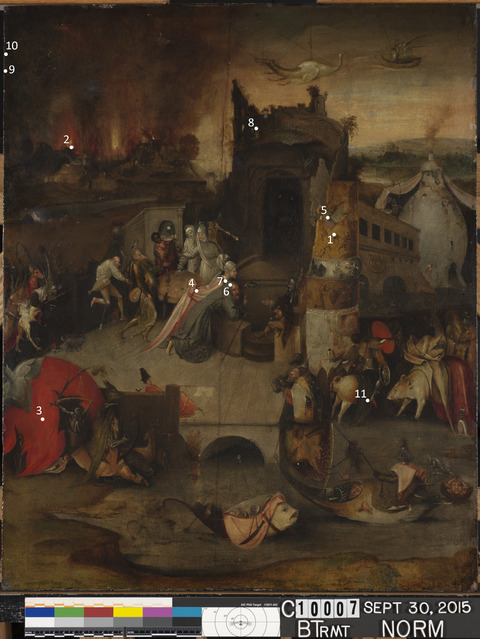
| Sample | Location | Elements | Possible Pigments |
|---|---|---|---|
| 1 | Pale yellow highlight on figure on tower | Major: Pb Minor: Fe, Sn, Ca Trace: Cu | Lead white, lead-tin yellow, iron oxide (earth pigments), calcium (likely from ground layer), trace of copper-containing green and/or blue pigment. |
| 2 | Light yellow flame in the background village | Major: Pb Minor: Sn, Ca Trace: Fe | Lead white, lead-tin yellow, vermilion, calcium (likely from ground layer), trace of iron oxide (earth pigments). |
| 3 | Red fruit | Major: Pb, Hg, Cu Minor: Fe, Ca Trace: | Lead white, vermilion, iron oxide (earth pigments), copper-containing green and/or blue pigment (likely from the lower layer), calcium (likely from ground layer). |
| 4 | Red drapery on central female figure | Major: Pb Minor: Cu, Fe, Ca Trace: Hg | Lead white, iron oxide (earth pigments including), calcium (likely from ground layer and possible red lake), copper-containing green and/or blue pigment, trace of vermilion. |
| 5 | Blue passage on tower | Major: Cu, Pb Minor: Fe, Ca Trace: Mn, K | Lead white, copper-containing blue (likely azurite), iron oxide (earth pigments including umber), calcium (likely from ground layer). |
| 6 | Gray robe of St. Anthony | Major: Pb, Cu, Fe Minor: Trace: Ca, Hg | Lead white, iron oxide (earth pigments), copper-containing green and/or blue pigment, trace of calcium (likely from ground layer), trace of vermilion. |
| 7 | White highlight on central female figure’s collar | Major: Pb Minor: Trace: Fe, Ca | Lead white, trace of calcium (likely from ground layer), trace of iron oxide (earth pigments). |
| 8 | Area of yellow ring from lower painting with black upper paint | Major: Pb Minor: Fe, Cu Trace: Ca, Sn | Lead white, lead-tin yellow, iron oxide (earth pigments), copper-containing green and/or blue pigment. |
| 9 | Green background of underlying portrait | Major: Cu Minor: Pb Trace: Fe, Ca, K | Copper-containing green pigment, lead white, trace of iron oxide (earth pigment), trace of calcium (likely from ground). |
| 10 | Ground layer under portrait | Major: Ca Minor: Trace: Pb | Calcium containing material (likely calcium carbonate), trace of lead white. |
| 11 | Blue-green blanket on knight’s mount | Major: Cu, Pb Minor: Fe Trace: Mn, Ca, K | Lead white, copper-containing green and/or blue pigment, iron oxide (earth pigment including umber), trace of calcium (likely from ground). |
Table 2: Results of X-ray fluorescence analysis conducted with a Bruker Artax microfocus XRF with rhodium tube, silicon-drift detector, and polycapillary focusing lens (~100μm spot).
*Major, minor, trace quantities are based on XRF signal strength not quantitative analysis
Surface Appearance:
Lean, paste, and rich vehicular paint structures applied in layers ranging from thick opaque paint to thin translucent films were noted under magnification. Individual pigment particles are also visible under magnification. The surface appears smooth overall, but age craquelure extends throughout the painting and in localized passages, most prominently within the yellow obelisk, which shows narrow aperture traction crackle (tech. fig. 18). A moderate amount of inpaint is present within areas of loss and abrasion.
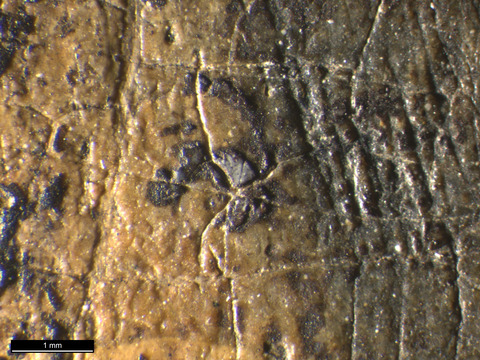
Condition of Paint
The paint layer exhibits very good adhesion to the support and cohesion throughout the strata, but inherent aging of original materials combined with chemically and mechanically induced damage from past treatment and handling have contributed to an abraded aesthetic condition. Technical figure 18 illustrates extreme mechanical abrasion noted within the center of the arched passage of the chapel and similar linear abrasion noted on the left side of the central platform (tech. fig. 19). The cause of such damage is not yet clear.
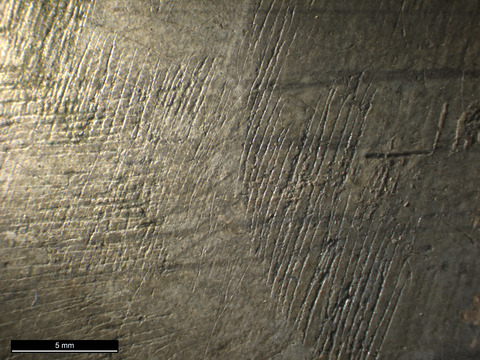
In addition to small losses around the periphery and within the picture plane, a centrally located vertical crack associated with the panel join extends through the picture layer and spans the full height of painting. A fine network of age craquelure, localized passages of traction crackle, and mechanical abrasion were also noted overall. All minor structural and major aesthetic damage has been addressed through treatment. Inpainting has proved successful in visually reintegrating damaged passages of paint with surrounding original paint, and varnish has improved the overall saturation and appearance of color.
Description of Varnish/Surface Coating
Analyzed Observed Documented
| Type of Varnish | Application |
|---|---|
| Natural resin | Spray applied |
| Synthetic resin/other | Brush applied |
| Multiple layers observed | Undetermined |
| No coating detected |
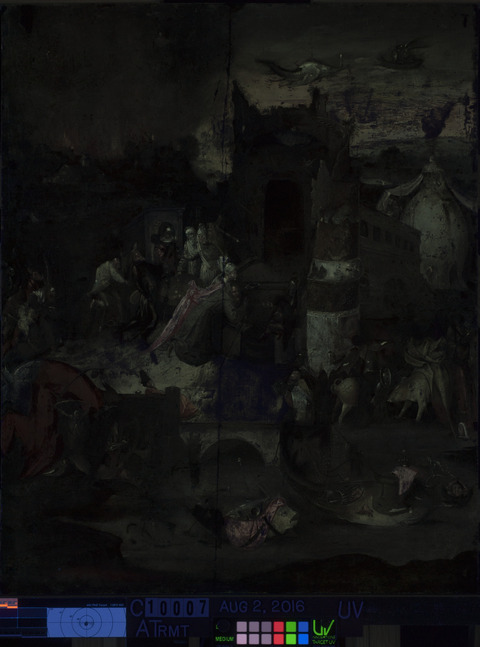
Condition of Varnish/Surface Coating
The painting is covered in a moderately thick coating of synthetic varnish (tech. fig. 20), initially applied as a barrier layer prior to inpainting and spray applied as a final coating after the conclusion of the latest treatment campaign in 2016. The aesthetic and protective properties of the varnish are excellent at this time. The paint appears fully saturated, and the surface displays a uniform semi-gloss overall.
Description of Frame
Original/first frame
Period frame
Authenticity cannot be determined at this time/ further art historical research necessary
Reproduction frame (fabricated in the style of)
Replica frame (copy of an existing period frame)
Modern frame
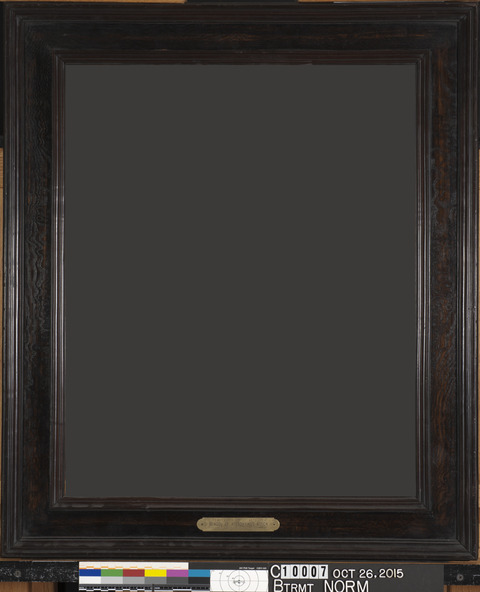
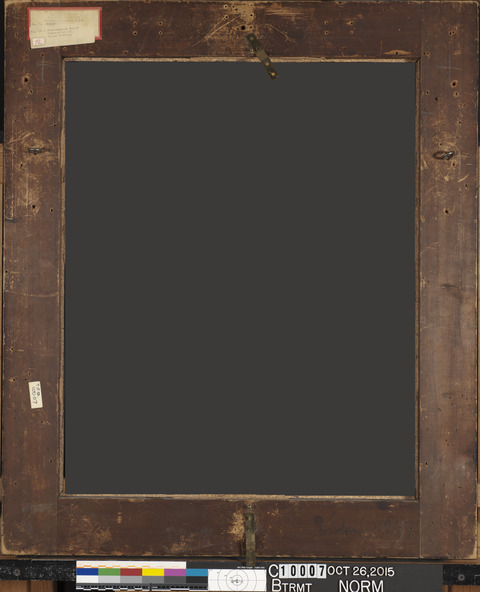
Frame Dimensions:
Outside frame dimensions: 77.2 × 66 × 4.2 cm
Sight size: 60 × 48.9 cm
Distinguishing Marks:
Item 4. Off-white paper collection/inventory label with a red border and typed text adhered to the top-left corner (back): “THE CLOWES FUND, INCORPORATED / FINE ARTS DEPARTMENT / 3744 SPRING HOLLOW ROAD / INDIANAPOLIS S. INDIANA. U. S. A. / No. 7. BOSCH”
Item 5. Off-white paper collection/inventory label with typed text adhered over the bottom half of the Clowes collection label, top-left corner (back): “No. 19 – Hieronymous Bosch / Temptation of / St. Anthony / 12”
Item 6. Off-white sticker adhered to the lower half of the left rail (back) with text written in black ink: “T.R. # / 10007”
Item 7. Handwritten cursive inscription at the right side of the bottom rail (back):

Description of Molding/Profile:
The cassetta-style frame (tech. fig. 21) is constructed of wood and joined at each corner with half-lapped joints (tech. fig. 22). The frame’s features show a shallow profile that exhibits a predominant wood-veneered flat section flanked by raised molding around the outer perimeter and the sight edge. The sides and front are stained dark brown, and the reverse appears to have a thin coating.
Condition of Frame
Past damage and delamination of the veneer wood occurred at the frame’s corners but was addressed during the 2016 treatment campaign. Some scuffs, nicks, and abrasion remain on the front overall, and the back shows marked abrasion, scuffs, and nail/screw holes around hanging hardware. However, the frame is stable and adequately supports and houses the painting.
Notes
-
Paul A.J. Spheeris, “Conservation Report on the Condition of the Clowes Collection,” 25 October 1971, Conservation Department Files, Indianapolis Museum of Art at Newfields. ↩︎
-
Martin Radecki, Clowes Collection condition assessment, undated (after October 1971), Conservation Department Files, Indianapolis Museum of Art at Newfields. ↩︎
-
Intermuseum Conservation Association, “Clowes Collection Conservation Report,” C10007 (2020.1), 8–10 April 1974, Conservation Department Files, Indianapolis Museum of Art at Newfields. ↩︎
-
Memorandum from Martin Radecki to Bret Waller, “Conservation Work on Clowes Fund Collection,” 16 February 1996, Conservation Department Files, Indianapolis Museum of Art at Newfields. ↩︎
-
Peter Klein, dendrochronological analysis report, C10007 (2020.1), 1999, Conservation Department Files, Indianapolis Museum of Art at Newfields. ↩︎
-
A letter dated 27 April 1945 addressed to William Valentiner, Detroit Institute of Arts, mentions the cleaning of the Temptation of St. Anthony: “I understand from Count Podgoursky that you have seen the Bosch ‘Temptation of St. Anthony’ since it was cleaned and that you found it very interesting and had intended to write to me about it. Unfortunately, I have never seen the picture in Lisbon and cannot tell, therefore, how it compares with that work…"; Conservation Historical File, Indianapolis Museum of Art at Newfields. ↩︎
-
The analyzed panel (60.5 × 49.0 cm) is made of two oak boards. “The wood concerned is originating from the Baltic/Polish region. Using this master chronology following dating could be obtained: board I: 177 growth rings: 1509–1333; board II: 154 growth rings: 1514–1361. The youngest heart-wood ring of the panel was formed out in the year 1512. Regarding the sapwood statistic for Eastern Europe, an earliest felling date can be derived with the year 1523. Based on the statistical variation of oak sapwood rings a felling date is more plausible between 1527...1529….1533 +x. With a minimum of a two-years storage time a creation is plausible from 1531 upwards.” Peter Klein, “Report on the dendrochronological analysis of the panel ‘Temptation of St. Anthony’ (H. Bosch, Follower, No. C10008),” Universität Hamburg, 20 July 1994, Conservation Department Files, Indianapolis Museum of Art at Newfields. ↩︎
-
Elvacite 2040 (synthetic resin) was not used to fill the cradle in this version of the X-radiograph. ↩︎
-
Elvacite 2040 (synthetic resin) was used to fill the cradle while shooting the X-radiograph so that the appearance of the cradle would be minimized in the X-radiograph and allow the composition to be better interpreted. ↩︎
-
http://www.museudearteantiga.pt/collections/european-painting/temptations-of-st-anthony , accessed 29 July 2021. ↩︎
-
Intermuseum Conservation Association Laboratory, report, 3 May 1974. Conservation Department Files, Indianapolis Museum of Art at Newfields. ↩︎
Additional Images
